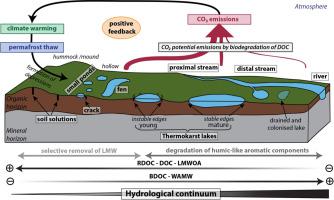Science of the Total Environment ( IF 8.2 ) Pub Date : 2020-08-05 , DOI: 10.1016/j.scitotenv.2020.141463 D Payandi-Rolland 1 , L S Shirokova 2 , M Tesfa 1 , P Bénézeth 1 , A G Lim 3 , D Kuzmina 3 , J Karlsson 4 , R Giesler 4 , O S Pokrovsky 5

|
Arctic regions contain large amounts of organic carbon (OC) trapped in soil and wetland permafrost. With climate warming, part of this OC is released to aquatic systems and degraded by microorganisms, thus resulting in positive feedback due to carbon (C) emission. In wetland areas, water bodies are spatially heterogenic and separated by landscape position and water residence time. This represents a hydrological continuum, from depressions, smaller water bodies and lakes to the receiving streams and rivers. Yet, the effect of this heterogeneity on the OC release from the soil and its processing in waters is largely unknown and not accounted for in C cycle models of Arctic regions. Here we investigated the dissolved OC (DOC) biodegradation of aquatic systems along a hydrological continuum located in two discontinuous permafrost sites: in western Siberia and northern Sweden. The biodegradable dissolved OC (BDOC15; % DOC lost relative to the initial DOC concentration after 15 days incubation at 20 °C) ranged from 0 to 20% for small water bodies located at the beginning of the continuum (soil solutions, small ponds, fen and lakes) and from 10 to 20% for streams and rivers. While the BDOC15 increased, the removal rate of DOC decreased along the hydrological continuum. The potential maximum CO2 production from DOC biodegradation was estimated to account for only a small part of in-situ CO2 emissions measured in peatland aquatic systems of northern Sweden and western Siberia. This suggests that other sources, such as sediment respiration and soil input, largely contribute to CO2 emissions from small surface waters of permafrost peatlands. Our results highlight the need to account for large heterogeneity of dissolved OC concentration and biodegradability in order to quantify C cycling in arctic water bodies susceptible to permafrost thaw.
中文翻译:

多年冻土泥炭地沿水文连续体的溶解性有机物生物降解。
北极地区的土壤和湿地永久冻土中含有大量的有机碳(OC)。随着气候变暖,该OC的一部分释放到水生系统中,并被微生物降解,因此由于碳(C)的排放而产生正反馈。在湿地地区,水体在空间上是异质的,并且被景观位置和水的停留时间隔开。这代表了一个水文连续性,从洼地,较小的水体和湖泊到接收溪流和河流。但是,这种异质性对土壤中OC释放及其在水中的OC的影响尚不清楚,在北极地区的C循环模型中并未解释。在这里,我们调查了位于两个不连续多年冻土区的水文连续体对水生系统的溶解性OC(DOC)生物降解作用:在西伯利亚西部和瑞典北部。可生物降解的溶解OC(BDOC15;相对于初始DOC浓度在20°C下孵育15天后,DOC损失百分比(%)对于连续过程开始时的小水体(土壤溶液,小池塘、,和湖泊)为0%至20%,而从10%至溪流和河流的20%。当BDOC 15增加时,DOC的去除率沿水文连续性下降。据估计,DOC生物降解产生的潜在最大CO 2产量仅占瑞典北部和西伯利亚西部泥炭地水生系统中测得的原位CO 2排放量的一小部分。这表明诸如泥沙呼吸和土壤输入等其他来源在很大程度上导致了CO 2的排放。多年冻土泥炭地小地表水的排放。我们的结果强调,需要对溶解的OC浓度和生物降解性的较大异质性进行说明,以便量化易受永冻土融化的北极水体中的C循环。














































 京公网安备 11010802027423号
京公网安备 11010802027423号